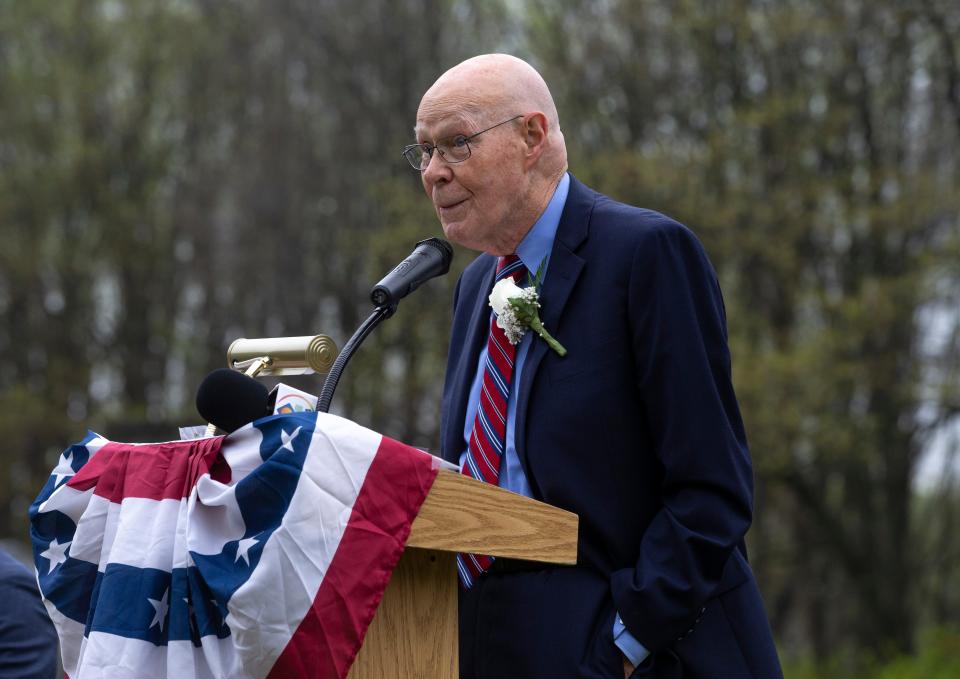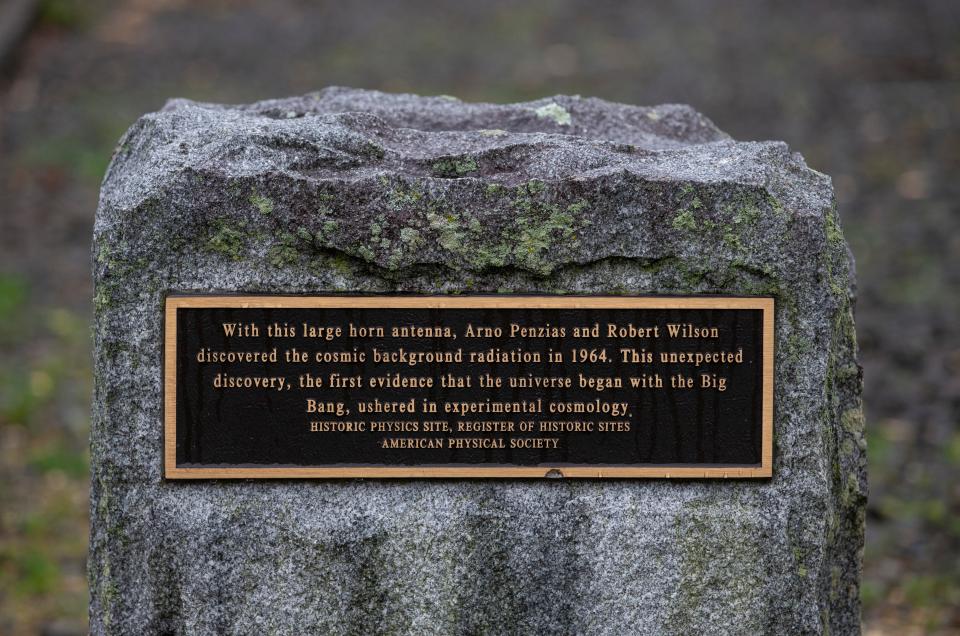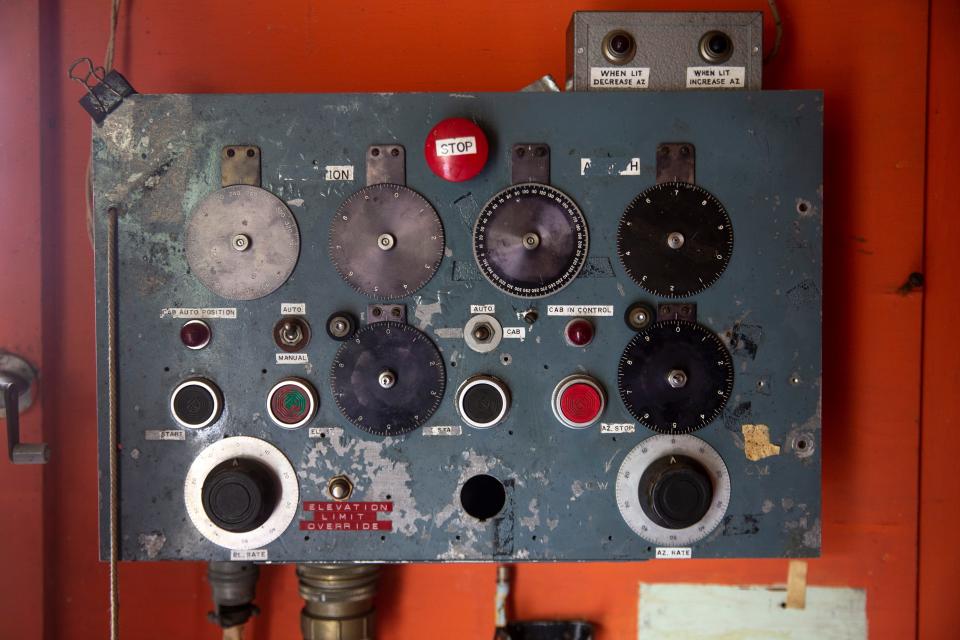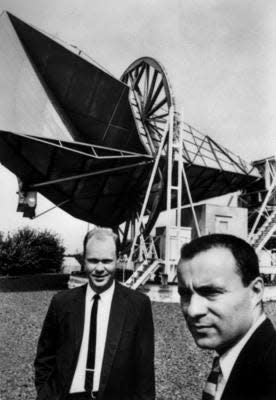Holmdel park dedicated to local scientist who discovered proof of the Big Bang theory
- Oops!Something went wrong.Please try again later.
- Oops!Something went wrong.Please try again later.
- Oops!Something went wrong.Please try again later.
HOLMDEL - Crawford Hill, home to the historic Horn Antenna, is now Dr. Robert Woodrow Wilson Park.
The new park is dedicated in honor of Holmdel resident and Nobel Laureate Dr. Robert Woodrow Wilson, who used the antenna to discover evidence for the Big Bang theory of the origin of the universe at the site in 1964. Holmdel held a dedication ceremony to officially designate the property at 791 Holmdel Road as a park.
Using the Horn Antenna, an 18-ton scientific instrument, Wilson and his fellow astronomer Arno Penzias first detected cosmic microwave background radiation. The pair were awarded the Nobel Prize in Physics in 1978.
The cosmic microwave background radiation proved to be crucial evidence of the Big Bang theory, which argues the universe was created with an enormous explosion around 14 billion years ago.
Due to its significance, the Horn Antenna is a National Historic Landmark. Earlier this year the township finalized its purchase of 35 acres of open space on the site where the Horn Antenna is located. The park was the subject of a years-long effort by the township and local activists to prevent development at the site.
During the dedication ceremony, Wilson told the crowd he was honored.
"I feel very lucky. I had a job at Bell Labs with very generous support and many helpful experts. I started my career when radio astronomy and cosmology were relatively new sciences but poised to blossom as technology developed," Wilson said.
"When I entered the workforce, the nation — perhaps shocked by Sputnik (the first satellite put in orbit by the Soviet Union in 1957) and remembering the contribution of science to winning World War II — understood the value of science for its future and was willing to spend the money to be the world leader in science and technology. It has been a wonderful ride."

Wilson spoke about the horn's history and radio astronomy in Holmdel, which began in 1933 with Karl G. Jansky, considered the father of radio astronomy, when Bell Labs announced that one of their scientists working in the Holmdel facility had succeeded in detecting radio waves from the Milky Way galaxy.
"We are all familiar with X-rays, visual light, infrared you can feel from a hot stove, microwaves and radio. These are all electromagnetic waves that increase in wavelength. Over the history of mankind astronomy was entirely visible, until recently. Astronomy now uses all of them," Wilson said.
In the 1950s, Bell Labs was working on using communication satellites and then in 1960, a speech by President Dwight D. Eisenhower' was the first broadcast using that technology.

Wilson was hired by Bell Labs in 1963 after he did a radio astronomy thesis at the California Institute of Technology, which made a measurement of the bright part of the Milky Way.
"One might ask why did Bell Labs hire two radio astronomers? I think there are two answers: The one they told upper management was that we would know about large antennas, communications/signals through the atmosphere and it would be very useful for satellite communications," Wilson said.
He added "I think the real reason was they did not continue Jansky’s work very well.
"They were proud of this instrument they had built, which was very low noise, and they knew it would do unique things for radio astronomy, and they wanted to see it used," Wilson said.
Wilson and Penzias worked with the Horn Antenna trying to measure the radio waves emanating from galaxies beyond our own Milky Way. But for nine months, while working on other projects, they kept running into what they thought was a problem, a persistent hum.

The hum was in fact not bird poop on the instrument like some initially believed, but noise from the origin of the universe, and the rest is history.
While speaking to the audience, Wilson shared a personal moment. On May 20, 1965, Wilson and Penzias received a call from Walter Sullivan, the lead scientific reporter for the New York Times, who asked various questions about their measurements. Later that day his father came to visit from Texas. The next morning while making breakfast, Wilson's father walked to the pharmacy in Holmdel Village and bought the paper.
"There on the front page of the Times was a picture of this antenna and an article describing our discovery. A happy time for father and son," Wilson said.

Wilson thanked Holmdel's previous mayor, Committeeman D.J. Luccarelli, for getting the process started, and current Mayor Rocco Impreveduto for seeing it through.
"To see how the community rallied around this, generating over 7,000 signatures and a petition, from over 50 countries, to make sure we preserve this land," Impreveduto said, "It is truly a community event and something we all embraced together."
Assemblywoman Vicky Flynn, R-Monmouth, who lives in Holmdel, thanked Wilson for his "super discovery,” and said future generations can learn a lot of from Wilson and the value of making mistakes.
"It is not about being perfect all the time, it is about learning from your mistakes. It applies in science, it applies to everything in life," Flynn said. "Those lessons are as significant as discovering the beginnings of the universe."
Jennifer Morgan, president of the Deeptime Network, told the Asbury Park Press that their global organization of 2,000-plus members had people fly in just to attend the ribbon-cutting.
"This discovery here was very instrumental in helping us to come this understanding of the universe as a whole and ourselves within it. It is just a huge breakthrough that this (park) is part of," Morgan said.
Sarbmeet Kanwal, an adjunct professor at Brookdale Community College and telecommunications professional, said, "This place opened our eyes to the fact that the radiation is coming from all directions and so we are actually at the center of the universe."
"That awakening is something that can really change the way we think about this whole universe, so to us it is very significant," Kanwal said.
Penzias, who worked at the Holmdel Bell Laboratories and shared the 1978 Nobel Prize in physics for his work with Wilson there, died earlier this year at the age of 90.
Charles Daye is the metro reporter for Asbury Park and Neptune, with a focus on diversity, equity and inclusion. @CharlesDayeAPP Contact him: CDaye@gannettnj.com.
This article originally appeared on Asbury Park Press: Park dedicated to Holmdel scientist who helped prove Big Bang theory

